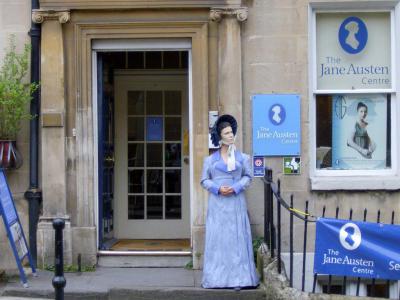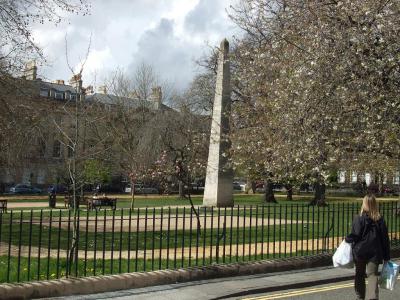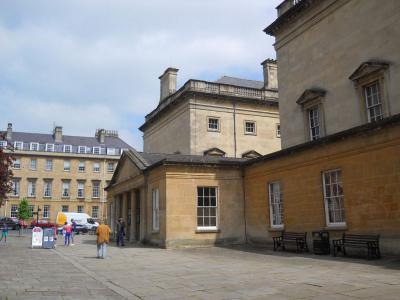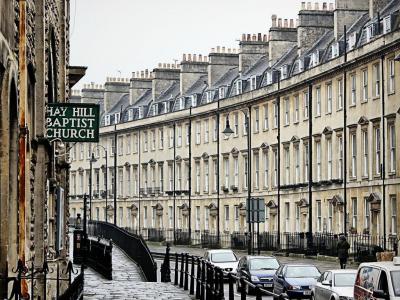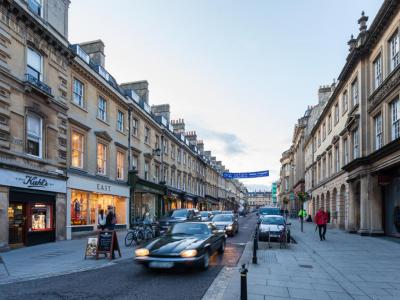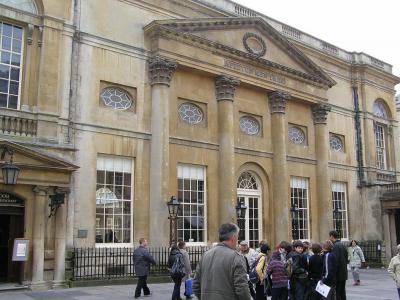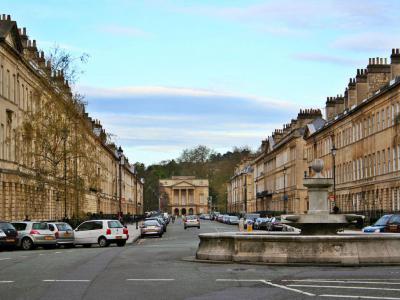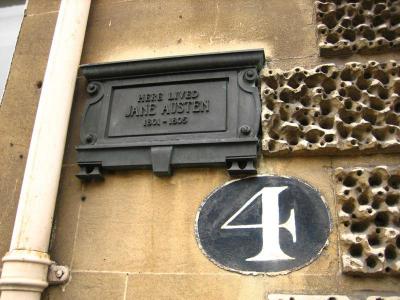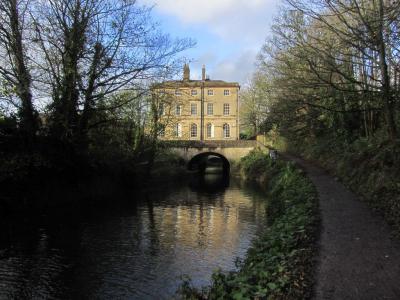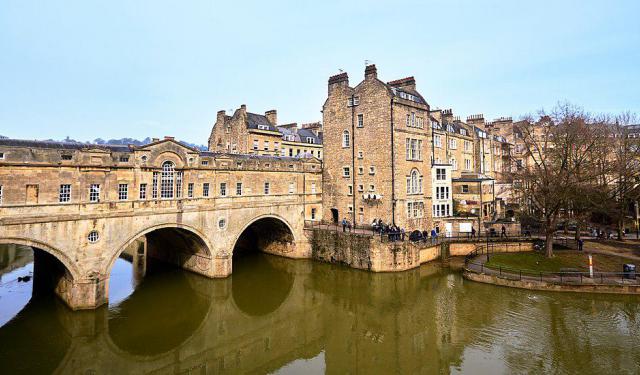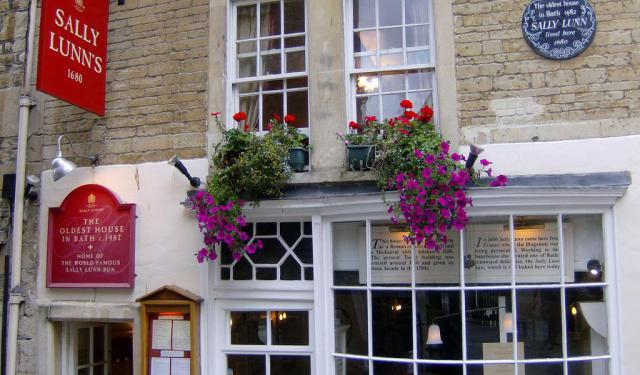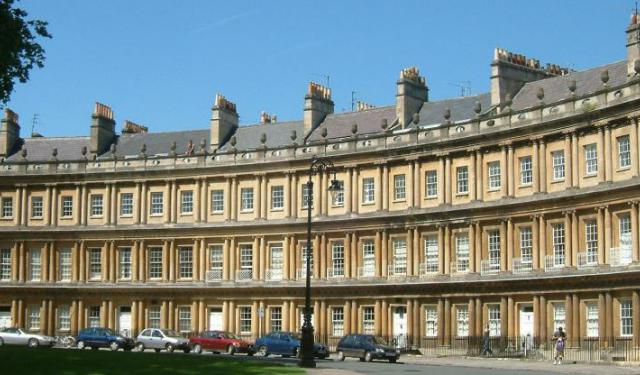Jane Austen Walking Tour (Self Guided), Bath
Jane Austen, 1775-1817, was a renowned British author. Her groundbreaking novels offer a witty and humorous look at Regency-era life. Austen's six novels have since inspired many popular TV adaptations and films.
Jane Austen lived in Bath from 1801 to 1806. Two of her novels, Northanger Abbey and Persuasion, were set in this beautiful Georgian city. While interiors have certainly been modernized since Austen's time, most exteriors and streets have been exquisitely preserved. You can see the residences Jane lived in, visit the Pump Rooms where her characters had tea, and visit the assembly rooms where Jane Austen danced the night away.
Don't miss the Jane Austen Center. You'll be intrigued by the life-sized wax statue of Jane Austen.
Fans will want to inspect the homes Jane Austen lived in. Admire Queen Square, where Austen stayed in 1799. She also stayed at her aunt's home in the Paragon. Jane and her characters loved shopping for the latest trends on Milsom Street, and you will too. Walk Great Pulteney Street to visit Jane's home on Sydney Place. Sydney Gardens provided an essential respite to Jane, and you, too, will feel rested and restored as you walk these beautiful gardens.
Follow Jane Austen's footsteps, dance along with Catherine Morland, and stroll Milsom Street with Anne Elliot in this self-guided walking tour.
Jane Austen lived in Bath from 1801 to 1806. Two of her novels, Northanger Abbey and Persuasion, were set in this beautiful Georgian city. While interiors have certainly been modernized since Austen's time, most exteriors and streets have been exquisitely preserved. You can see the residences Jane lived in, visit the Pump Rooms where her characters had tea, and visit the assembly rooms where Jane Austen danced the night away.
Don't miss the Jane Austen Center. You'll be intrigued by the life-sized wax statue of Jane Austen.
Fans will want to inspect the homes Jane Austen lived in. Admire Queen Square, where Austen stayed in 1799. She also stayed at her aunt's home in the Paragon. Jane and her characters loved shopping for the latest trends on Milsom Street, and you will too. Walk Great Pulteney Street to visit Jane's home on Sydney Place. Sydney Gardens provided an essential respite to Jane, and you, too, will feel rested and restored as you walk these beautiful gardens.
Follow Jane Austen's footsteps, dance along with Catherine Morland, and stroll Milsom Street with Anne Elliot in this self-guided walking tour.
How it works: Download the app "GPSmyCity: Walks in 1K+ Cities" from Apple App Store or Google Play Store to your mobile phone or tablet. The app turns your mobile device into a personal tour guide and its built-in GPS navigation functions guide you from one tour stop to next. The app works offline, so no data plan is needed when traveling abroad.
Jane Austen Walking Tour Map
Guide Name: Jane Austen Walking Tour
Guide Location: England » Bath (See other walking tours in Bath)
Guide Type: Self-guided Walking Tour (Sightseeing)
# of Attractions: 9
Tour Duration: 2 Hour(s)
Travel Distance: 2.5 Km or 1.6 Miles
Author: rose
Sight(s) Featured in This Guide:
Guide Location: England » Bath (See other walking tours in Bath)
Guide Type: Self-guided Walking Tour (Sightseeing)
# of Attractions: 9
Tour Duration: 2 Hour(s)
Travel Distance: 2.5 Km or 1.6 Miles
Author: rose
Sight(s) Featured in This Guide:
- Jane Austen Centre
- Queen Square
- Bath Assembly Rooms
- Paragon
- Milsom Street
- Grand Pump Room
- Great Pulteney Street
- Jane Austen’s Home
- Sydney Gardens
1) Jane Austen Centre (must see)
Nothing typifies Regency life in Bath so much as a classic Jane Austen novel. The world-renown author lived in Bath from 1801 to 1806. Two of her novels, Northanger Abbey and Persuasion, were set here. So it's no surprise that in Bath you will find the Jane Austen Centre. Nestled in a Georgian house near the imposing Bath Abbey, The Circus, and the Roman Baths, this museum aims to share the wonders of Austen's Georgian-era Bath with the world.
The Centre has actors in Regency costume to create an immersive experience. There is a carefully crafted, waxwork statue of Jane. The waxwork often surprises visitors as it stands at 5'8", quite tall for a Georgian lady. Forensic artists spent over three years creating the sculpture. There is only one likeness of Jane Austen; a portrait drawn by her sister, Cassandra. However, other family members criticized the portrait and felt it did not capture the true Jane Austen. See for yourself whether or not the sculpture matches your expectations. You'll also find a gift shop and a tea room operated by the Centre.
Why You Should Visit:
Ardent Jane Austen fans will need no encouragement to stop at the Jane Austen Centre. But the Centre is designed as an immersive experience for the whole family, with guides in period costumes add to the charm. Learn about Bath's history, especially about Regency-era life and customs.
The building itself, part of a block on Gay Street, is an English Heritage Grade II listed building.
Tips:
The Centre organizes Bath's Jane Austen Festival every year in September. The ten-day celebration features over 80 events, including a summer ball, a costumed promenade, and a masquerade ball.
Do not miss the Centre's Regency Tea Room, which has been awarded the Tea Guild's Award of Excellence. If you've visited the Centre, you get 10 percent off at the Tea Room.
The Centre has actors in Regency costume to create an immersive experience. There is a carefully crafted, waxwork statue of Jane. The waxwork often surprises visitors as it stands at 5'8", quite tall for a Georgian lady. Forensic artists spent over three years creating the sculpture. There is only one likeness of Jane Austen; a portrait drawn by her sister, Cassandra. However, other family members criticized the portrait and felt it did not capture the true Jane Austen. See for yourself whether or not the sculpture matches your expectations. You'll also find a gift shop and a tea room operated by the Centre.
Why You Should Visit:
Ardent Jane Austen fans will need no encouragement to stop at the Jane Austen Centre. But the Centre is designed as an immersive experience for the whole family, with guides in period costumes add to the charm. Learn about Bath's history, especially about Regency-era life and customs.
The building itself, part of a block on Gay Street, is an English Heritage Grade II listed building.
Tips:
The Centre organizes Bath's Jane Austen Festival every year in September. The ten-day celebration features over 80 events, including a summer ball, a costumed promenade, and a masquerade ball.
Do not miss the Centre's Regency Tea Room, which has been awarded the Tea Guild's Award of Excellence. If you've visited the Centre, you get 10 percent off at the Tea Room.
2) Queen Square
In 1799, the Austen family visited Bath so that Jane's brother, Edward, could "take the cure" at the healing baths. During this visit, the Austens stayed at No. 13 Queen Square. Jane wrote to her sister Cassandra that they were "exceedingly pleased with the house; the rooms are quite as large as we expected."
However, in Persausion, Louisa Musgrove said, "I hope we shall be in Bath in the winter; but remember, papa, if we do go, we must be in a good situation: none of your Queen Squares for us!" This quote shows that Queen Square was fashionable and new in the 1730s. But by the time Persausion was published in 1817, Queen Square was not up to the latest and most fashionable standards.
John Wood, the Elder, developed Queen Square. It was named for Queen Caroline and intended to appear like a palace with wings. He designed the facade in Palladian style. Queen Square was his first speculative build in Bath. Wood leased the land, designed the frontage, divided the ground, and then sub-let to other builders. These builders would then build individual homes behind the facades.
The square's center obelisk was erected in 1738 by Beau Nash and is dedicated to Frederick, Prince of Wales. Queen Square quickly became popular, and its success allowed John Wood, the Elder, to continue his rebuilding of Bath.
However, in Persausion, Louisa Musgrove said, "I hope we shall be in Bath in the winter; but remember, papa, if we do go, we must be in a good situation: none of your Queen Squares for us!" This quote shows that Queen Square was fashionable and new in the 1730s. But by the time Persausion was published in 1817, Queen Square was not up to the latest and most fashionable standards.
John Wood, the Elder, developed Queen Square. It was named for Queen Caroline and intended to appear like a palace with wings. He designed the facade in Palladian style. Queen Square was his first speculative build in Bath. Wood leased the land, designed the frontage, divided the ground, and then sub-let to other builders. These builders would then build individual homes behind the facades.
The square's center obelisk was erected in 1738 by Beau Nash and is dedicated to Frederick, Prince of Wales. Queen Square quickly became popular, and its success allowed John Wood, the Elder, to continue his rebuilding of Bath.
3) Bath Assembly Rooms
There are two sets of Assembly Rooms: the Lower Rooms and the Upper Rooms. The Lower Rooms were built in 1708 and are located in the older part of the city. The Upper Rooms were built in a more fashionable part of town, near The Circus and the Royal Crescent, hence the "upper" description. The lower rooms burned in 1820 and were not rebuilt.
Today, you can still visit the Upper Rooms and glory in their beauty. Don't miss the original Wayfarers crystal chandeliers. The Fashion Museum is also located in the Assembly Rooms and is well worth a visit. Be sure to admire all the Regency era dresses.
The Assembly Rooms were another center of Regency life in Jane Austen's time. Jane Austen loved dancing, and she spent time in the Assembly Rooms attending evening balls - dancing, watching, and gossiping.
In Persausion, Anne Elliot hopes to visit the Assembly Rooms and meet Captain Wentworth. But her father felt that the Assembly Rooms were not fashionable enough for the Elliots. Later on, however, the Elliots did accept an invitation to a concert in the Upper Rooms, and the meeting did take place.
In Northanger Abbey, Catherine Morland often visits both the Upper Rooms and the Lower Rooms and dances the nights away in crowded rooms. Catherine Morland met Henry Tilney in the Lower Rooms, and Henry Tilney found the Master of Ceremonies to introduce them. Isabella Thorpe was affronted when James Morland asks for more dances without changing partners. These vignettes give insight into the different, more restrictive social norms of Regency England.
Today, you can still visit the Upper Rooms and glory in their beauty. Don't miss the original Wayfarers crystal chandeliers. The Fashion Museum is also located in the Assembly Rooms and is well worth a visit. Be sure to admire all the Regency era dresses.
The Assembly Rooms were another center of Regency life in Jane Austen's time. Jane Austen loved dancing, and she spent time in the Assembly Rooms attending evening balls - dancing, watching, and gossiping.
In Persausion, Anne Elliot hopes to visit the Assembly Rooms and meet Captain Wentworth. But her father felt that the Assembly Rooms were not fashionable enough for the Elliots. Later on, however, the Elliots did accept an invitation to a concert in the Upper Rooms, and the meeting did take place.
In Northanger Abbey, Catherine Morland often visits both the Upper Rooms and the Lower Rooms and dances the nights away in crowded rooms. Catherine Morland met Henry Tilney in the Lower Rooms, and Henry Tilney found the Master of Ceremonies to introduce them. Isabella Thorpe was affronted when James Morland asks for more dances without changing partners. These vignettes give insight into the different, more restrictive social norms of Regency England.
4) Paragon
The Paragon, located in the Walcot area of Bath, is a renowned street notable for its Georgian architecture. This historic street is characterized by a series of elegant Georgian houses, each designated as listed buildings, exemplifying the architectural style of the period.
Designed by Thomas Warr Attwood, the street is distinguished by its uniform houses, which contribute significantly to the area's architectural heritage. Numbers 1 to 21 on The Paragon are three-story houses, each featuring mansard roofs. A notable aspect of these buildings is their symmetrical design, with matching doors and windows. The central pediments and flat entablatures flanking the first-floor windows add to their classical Georgian charm. Additionally, the doorways are adorned with Tuscan pilasters and pediments, enhancing the street's aesthetic appeal.
The theme established by the houses from numbers 1 to 21 is seamlessly continued in numbers 22 to 37. These additional houses were completed in 1775 by Joseph Axford, a local mason. The continuity in architectural style across these numbers showcases the planned urban development characteristic of Georgian Bath.
The Paragon's historical significance is further enriched by its possible roots as a Roman road. It is believed to have originated from Aquae Sulis, leading north and connecting with the Fosse Way. Although mapping evidence suggests a medieval origin, the area of Walcot, where The Paragon is located, has a history of Roman residential development dating from the 1st to 3rd centuries.
Notably, Jane Austen visited No. 1 The Paragon on two occasions, which happened to be her aunt's residence. Her first visit was for a casual stay, while her second stay served as temporary accommodation while she searched for her own place to live. Now, you have the opportunity to rent The Paragon as your dwelling and follow in the footsteps of Jane Austen, exploring the places she frequented and even recreating the dances of her beloved characters.
Designed by Thomas Warr Attwood, the street is distinguished by its uniform houses, which contribute significantly to the area's architectural heritage. Numbers 1 to 21 on The Paragon are three-story houses, each featuring mansard roofs. A notable aspect of these buildings is their symmetrical design, with matching doors and windows. The central pediments and flat entablatures flanking the first-floor windows add to their classical Georgian charm. Additionally, the doorways are adorned with Tuscan pilasters and pediments, enhancing the street's aesthetic appeal.
The theme established by the houses from numbers 1 to 21 is seamlessly continued in numbers 22 to 37. These additional houses were completed in 1775 by Joseph Axford, a local mason. The continuity in architectural style across these numbers showcases the planned urban development characteristic of Georgian Bath.
The Paragon's historical significance is further enriched by its possible roots as a Roman road. It is believed to have originated from Aquae Sulis, leading north and connecting with the Fosse Way. Although mapping evidence suggests a medieval origin, the area of Walcot, where The Paragon is located, has a history of Roman residential development dating from the 1st to 3rd centuries.
Notably, Jane Austen visited No. 1 The Paragon on two occasions, which happened to be her aunt's residence. Her first visit was for a casual stay, while her second stay served as temporary accommodation while she searched for her own place to live. Now, you have the opportunity to rent The Paragon as your dwelling and follow in the footsteps of Jane Austen, exploring the places she frequented and even recreating the dances of her beloved characters.
5) Milsom Street
Thomas Lightholder built Milsom Street in 1762. Designed initially as houses, they were converted into shops. Milsom Street was the most popular shopping street in Bath during Jane Austen's time. Austen was sure to have spent many hours strolling Milsom Street and admiring bonnets, ribbons, and muslins. She wrote letters to her sister Cassandra detailing the latest fashions seen along Milsom Street.
Her characters not only shopped and strolled but experienced chance meetings on Milsom Street. In Northanger Abbey, Isabella Thorpe remarked to Catherine Morland, "I just saw the prettiest hat in a shop window in Milsom Street". Northanger Abbey's General Tilney had lodgings on Milsom Street.
In Persuasion, Anne Elliot comes across Admiral Croft on Milsom Street. He is in such deep contemplation of a painting in a shop window that it takes Anne several attempts to catch his notice. The Admiral laughs and mentions that he can never go past this shop without stopping. Anne Elliot later visits Mollands, a trendy pastry and confectionary shop at that time. It was here that Anne Elliot had a surprise meeting with Captain Wentworth.
Not much has changed on Milsom street since Jane Auten's time. Shops still sell the latest fashions, and peckish shoppers are sure to find a sweet treat to enjoy. Milsom Street has been voted "Britain's Best Fashion Street".
Her characters not only shopped and strolled but experienced chance meetings on Milsom Street. In Northanger Abbey, Isabella Thorpe remarked to Catherine Morland, "I just saw the prettiest hat in a shop window in Milsom Street". Northanger Abbey's General Tilney had lodgings on Milsom Street.
In Persuasion, Anne Elliot comes across Admiral Croft on Milsom Street. He is in such deep contemplation of a painting in a shop window that it takes Anne several attempts to catch his notice. The Admiral laughs and mentions that he can never go past this shop without stopping. Anne Elliot later visits Mollands, a trendy pastry and confectionary shop at that time. It was here that Anne Elliot had a surprise meeting with Captain Wentworth.
Not much has changed on Milsom street since Jane Auten's time. Shops still sell the latest fashions, and peckish shoppers are sure to find a sweet treat to enjoy. Milsom Street has been voted "Britain's Best Fashion Street".
6) Grand Pump Room
The Grand Pump Room has been an intricate part of the Bath social scene since it opened. The current building opened in 1795, built upon an early building's foundations from the early 1700s. Famous visitors have included Jane Austen and Charles Dickens.
The Grand Pump Room is currently the entrance to the Roman Baths and features the Grand Pump Room Restaurant. It's a great place to take the waters and to dine in the opulent surroundings one would expect for such an affair.
The Grand Pump Room was a prime setting in some of Austen's novels. In Northanger Abbey, it is here that Catherine Morland makes her first forays into Bath society. In one passage of the novel, Catherine Morland found the crowd in the Pump Room insupportable. In another, she eagerly checked for Henry Tilney's name in the visitor's book and was disappointed not to find it. Visitors would sign in, and this book was a useful tool to track the comings and goings of acquaintances. In Persuasion, Admiral Croft comes to Bath to take the waters as a cure for his gout.
The Grand Pump Room is currently the entrance to the Roman Baths and features the Grand Pump Room Restaurant. It's a great place to take the waters and to dine in the opulent surroundings one would expect for such an affair.
The Grand Pump Room was a prime setting in some of Austen's novels. In Northanger Abbey, it is here that Catherine Morland makes her first forays into Bath society. In one passage of the novel, Catherine Morland found the crowd in the Pump Room insupportable. In another, she eagerly checked for Henry Tilney's name in the visitor's book and was disappointed not to find it. Visitors would sign in, and this book was a useful tool to track the comings and goings of acquaintances. In Persuasion, Admiral Croft comes to Bath to take the waters as a cure for his gout.
7) Great Pulteney Street
At 1,000 feet long and 100 feet wide, the Great Pulteney Street is the most impressive in Bath. The houses along the street were commissioned by Sir William Pulteney and designed by Thomas Baldwin. Mr. Baldwin designed the exterior facade to be unifying. However, the houses and hotels behind the facades are all unique.
Great Pulteney Street would have been very familiar to Jane Austen. From her residence at Sydney Place, she would have walked Great Pulteney Street to reach the center of town. In Northanger Abbey, Catherine Morland's aunt and uncle the Allen's had lodgings in Great Pulteney Street, and it was here that Catherine stayed during her time in Bath. The Allen's house was considered enormous and very fashionable.
Don't miss Laura Place, connected to Great Pulteney Street. In Persuasion, the Elliot's wealthy cousins, the Dowager Viscountess Dalrymple and the Honourable Miss Carteret, resided at the very prestigious and fashionable Laura Place.
Great Pulteney Street would have been very familiar to Jane Austen. From her residence at Sydney Place, she would have walked Great Pulteney Street to reach the center of town. In Northanger Abbey, Catherine Morland's aunt and uncle the Allen's had lodgings in Great Pulteney Street, and it was here that Catherine stayed during her time in Bath. The Allen's house was considered enormous and very fashionable.
Don't miss Laura Place, connected to Great Pulteney Street. In Persuasion, the Elliot's wealthy cousins, the Dowager Viscountess Dalrymple and the Honourable Miss Carteret, resided at the very prestigious and fashionable Laura Place.
8) Jane Austen’s Home
Jane Austen resided at No. 4 Sydney Place in the early 1800s. Here, you will find a commemorative plaque "Here lived Jane Austen, 1801-1805". Austen worked on the unfinished novel "The Watsons" inside this home. She abandoned the novel after her father's death in 1805.
Jane loved walking through Sydney Gardens and therefore was relieved to live in a location with easy access. In 1801, Sydney Place, located on the east side of Pulteney Bridge, was a newly built terrace house. Its location was quiet but offered easy access to Bath's social and shopping scene over Pulteney Bridge.
During her time in Bath, Jane Austen also had residences at other locations. The Austen family first rented a house on Gay Street, a few doors down from the Jane Austen Centre. Next, they lived at Sydney Place. This is considered to be Jane Austen's home in Bath because the family stayed here for the most prolonged duration. In 1805, the lease on Sydney Place ran out, and the family moved to Green Park Building East, where Jane Austen's father died. Next, they moved to No. 25 Gay Street. Finally, they moved to Trim Street, a more affordable address.
Jane loved walking through Sydney Gardens and therefore was relieved to live in a location with easy access. In 1801, Sydney Place, located on the east side of Pulteney Bridge, was a newly built terrace house. Its location was quiet but offered easy access to Bath's social and shopping scene over Pulteney Bridge.
During her time in Bath, Jane Austen also had residences at other locations. The Austen family first rented a house on Gay Street, a few doors down from the Jane Austen Centre. Next, they lived at Sydney Place. This is considered to be Jane Austen's home in Bath because the family stayed here for the most prolonged duration. In 1805, the lease on Sydney Place ran out, and the family moved to Green Park Building East, where Jane Austen's father died. Next, they moved to No. 25 Gay Street. Finally, they moved to Trim Street, a more affordable address.
9) Sydney Gardens
Sydney Gardens, originally named Bath Vauxhall Gardens, is a significant public open space located at the end of Great Pulteney Street in Bath. Esteemed for being the only remaining eighteenth-century pleasure gardens in the country, these gardens hold a prestigious Grade II listing on the Register of Historic Parks and Gardens of special historic interest in England.
The gardens were initially laid out in the 1790s, based on the designs of Thomas Baldwin, which were later completed by Charles Harcourt Masters. They were designed as gardens with attractions like a maze, grotto, sham castle, and animated rural scenes. These gardens were a hub for social events like promenades, public breakfasts, and were frequented by notable figures such as Jane Austen. Jane Austen, seeking solace from city life, found refuge in the natural beauty of the gardens, where she could indulge in flower gardens, breakfasts, picnics, and outdoor concerts. She even mentioned in a letter how the fireworks and illuminations in Sydney Gardens exceeded her expectations.
Throughout history, the layout of Sydney Gardens has been influenced by the construction of the Kennet & Avon Canal in 1810 and the Great Western Railway in 1840, both of which pass through the park. Despite a period of decline, the gardens were purchased by the local council in 1908 and reopened as a public park. Since 2015, efforts have been made to enhance the park's environment and offer additional attractions to visitors.
One of the central features of Sydney Gardens was the Sydney Hotel, now the Holburne Museum, which served as the focal point for entertainment. Other historical structures include walls and bridges associated with the canal and railway, small buildings now referred to as the pavilion and Minerva's temple, and the public conveniences, all of which are listed buildings.
The gardens were initially laid out in the 1790s, based on the designs of Thomas Baldwin, which were later completed by Charles Harcourt Masters. They were designed as gardens with attractions like a maze, grotto, sham castle, and animated rural scenes. These gardens were a hub for social events like promenades, public breakfasts, and were frequented by notable figures such as Jane Austen. Jane Austen, seeking solace from city life, found refuge in the natural beauty of the gardens, where she could indulge in flower gardens, breakfasts, picnics, and outdoor concerts. She even mentioned in a letter how the fireworks and illuminations in Sydney Gardens exceeded her expectations.
Throughout history, the layout of Sydney Gardens has been influenced by the construction of the Kennet & Avon Canal in 1810 and the Great Western Railway in 1840, both of which pass through the park. Despite a period of decline, the gardens were purchased by the local council in 1908 and reopened as a public park. Since 2015, efforts have been made to enhance the park's environment and offer additional attractions to visitors.
One of the central features of Sydney Gardens was the Sydney Hotel, now the Holburne Museum, which served as the focal point for entertainment. Other historical structures include walls and bridges associated with the canal and railway, small buildings now referred to as the pavilion and Minerva's temple, and the public conveniences, all of which are listed buildings.
Walking Tours in Bath, England
Create Your Own Walk in Bath
Creating your own self-guided walk in Bath is easy and fun. Choose the city attractions that you want to see and a walk route map will be created just for you. You can even set your hotel as the start point of the walk.
Bath Introduction Walking Tour
The only English city designated a UNESCO World Heritage site, Bath is a gorgeous city packed with history. Artifacts have been found from the Bronze and Iron Age in the surrounding hills. The Romans were the first to build around the remarkable hot mineral springs at the beginning of the first century. They constructed a temple and baths here, and since then, people have flocked to Bath for its... view more
Tour Duration: 2 Hour(s)
Travel Distance: 2.5 Km or 1.6 Miles
Tour Duration: 2 Hour(s)
Travel Distance: 2.5 Km or 1.6 Miles
Historical Homes Walking Tour
Apart from its Roman thermae, the city of Bath is renowned for its prominent residents who used to live here a long time ago. Their former dwellings – historical monuments in their own right – now offer a captivating glimpse into the city's glorious past.
Among the most famous of them, undoubtedly, is the Jane Austen Centre. This charming Georgian townhouse provides a fascinating look... view more
Tour Duration: 1 Hour(s)
Travel Distance: 1.6 Km or 1 Miles
Among the most famous of them, undoubtedly, is the Jane Austen Centre. This charming Georgian townhouse provides a fascinating look... view more
Tour Duration: 1 Hour(s)
Travel Distance: 1.6 Km or 1 Miles
Georgian Architecture Walking Tour
Another prominent attraction of Bath is its wonderful Georgian architecture. Many a street and square here are richly adorned with distinctively stylish buildings. In large part, the city owes it to two architects – father and son: John Wood, the Elder, and John Wood, the Younger. Constructed mostly from Bath Stone, a creamy limestone obtained in Combe Down and Bathampton Down Miles, these... view more
Tour Duration: 1 Hour(s)
Travel Distance: 2.2 Km or 1.4 Miles
Tour Duration: 1 Hour(s)
Travel Distance: 2.2 Km or 1.4 Miles
The Most Popular Cities
/ view all



